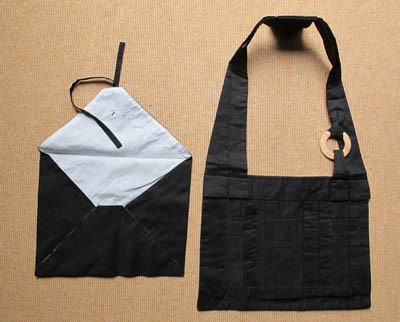
Still Center Zen Order
Inclusion
We are a welcoming, multi-cultural,
open-minded community that aims
to provide a safe space for all
members. We welcome everyone
regardless of their gender or sexual
identity. LGBT+ members may sew
a rainbow rakusu when taking Jukai
. 功夫 Training
Precept Training (Jukai)
The first step on the path to more serious training at SCZO is to study the precepts
and take what we call "Jukai" (literally, to receive the precepts). For many, this is the
only step they will take, unless they feel particularly called to train as a Zen Priest
or a Lay Zen Teacher (see below). Jukai takes place in a ceremony at which members
of SCZO attend to witness your taking this step. Upon completing Jukai you will
receive a dharma name and be permitted to wear a rakusu -- the 'bib' like clothing
you may see many Zen practioners wearing. The rakusu represents a mini version of
the Buddha's robes, and in our tradition you will usually sew your own rakusu as
part of the precept training process prior to taking Jukai.
Here is an example of one:

Jukai is also known as Lay Buddhist Ordination, not to be confused with priestly
ordination that grants permission to use the term "reverend" or conduct wedding
ceremonies, etc.
There are 16 precepts that you will study in weekly classes, either
taken in a group or one-on-one with a Teacher/Priest. The 16 consist of:
The Three Treasures (Refuges, Jewels)
Buddha
Dharma
Sangha
The Three Pure Precepts
Do No Evil
Do Good
Do Good for Others
The Ten Grave Precepts
Non-Killing
Non-Stealing
Not Being Greedy
Not Telling Lies
Not Being Ignorant
Not Talking about Other's Faults
Not Elevating Oneself and Blaming Others
Not Being Stingy
Not Being Angry
Not Speaking Ill of the Three Treasures
If you are interested in taking the precepts and receiving Jukai, then please email
StillCenterZen@gmail.com to express your interest. Training usually takes place
online using Zoom, but may occasionally be available in person depending on
your geographic location.
* * *
Soto Priest Training
Unlike traditional Japanese Soto Zen Priest Ordination, SCZO does not require
its priests to shave their heads. Of course, ordained SCZO priests may have their
head shaved if they wish, but it is their choice, not a requirement of ordination.
While Zen is for everyone, formal recognition may not be. Pursuing a path to
become ordained is not one to be taken lightly and requires tremendous com-
mittment by the student. If your calling includes pursuing a career path such as
chaplaincy, then we encourage you to make this clear when contacting us about
your interest in becoming a Zen Priest. We may be able to endorse you and assist
you in your path to becoming a Board Certified Chaplain (Roshi Ryuko is a Board
Certified Chaplain). The path to becoming a Soto Zen Priest has several stages:
1. Disciple (discernment phase) - prerequisite having completed Jukai
2. Novice Priest (Shukke Tokudo) -- prerequesite completing discernment
3. Head Novice Priest (Shuso) - prerequsite Shukke Tokudo
4. Transmitted Priest - prerequisite Shuso
There is no fixed timeframe for this process of becoming a fully ordained Soto
Zen Priest. Typically, the process takes at least 3-years, but may take longer for
some candidates. Training will include basic knowledge of the dharma and teachings
of the Buddha, training in liturgy and ceremonial practices, conducting services, the
robes, okesas, and formal clerical clothing practices, attending a minimum required
number of retreats, and other aspects including an introduction to koan introspection.
If you are interested in following this path then please send an email of expression of
interest to StillCenterZen@gmail.com
***
Lay Zen Teacher Training
The Lay Zen Teacher Training offered at SCZO is in the White Plum Asanga
tradition of Maezumi Roshi and through the school of Zen established by
Al Fusho Rapaport, Roshi of Open Mind Zen. The goal of this training is to
establish Lay Zen Teachers who can teach others how to undertake koan
introspection. The student in this program will complete the
koan curriculum,
which is largely based on the Yasutani-Harada curriculum
used
by
the
White
Plum Asanga and which is similar to that used by many
other Soto Zen groups,
and has similarity with the training given in Rinzai
Zen groups. The collections
of koans studied as part of this training include
our own list of
introductory
koans, followed by study of The Gateless Gate (Mumonkan), The Blue Cliff
Record and other collections such as the work
often used by Rinzai teachers,
Entangling Vines. There are three stages in
this training: Apprentice Teacher
(no title), Assistant Teacher (title of Assistant
Teacher), and Full Transmitted
Teacher (title of full Teacher/Sensei). At the
Assistant Teacher level
the
student
is authorized to teach others koan introspection
under supervision of his or
her
teacher, while at the transmitted Teacher level the
Teacher is now able to teach
without supervision. If you are interested in pursuing
this path then
please write expressing interest to StillCenterZen@gmail.com
(c) 2023 Still Center Zen Order (a California Non-Profit Religious Organization)